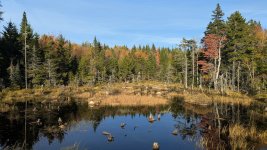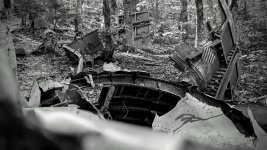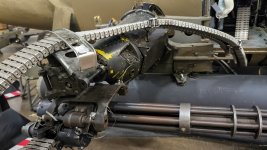Trans Maine Overland Trail
Part One of Three
After years of chasing backcountry routes across the country - from the Appalachians to the Southwest deserts, Great Plains to coastal dunes - the
Trans Maine Overland Trail (TMOT) stands out as a raw traverse through Maine’s remote interior, stitched together by forgotten logging roads, mountain passes, backcountry paths, and moose-haunted forests, where cell service fades and self-reliance takes over for hundreds of miles of moderate, immersive wilderness travel. The TMOT offers two routes: a 373-mile (blue) west-to-north path from the western border to the state’s northern edge, and a 237-mile (green) eastern expansion connector that extends the journey to Maine’s eastern tip. I have chosen the 373-mile west-to-north route, which ends farther north than the entire province of Nova Scotia.

Much of the TMOT passes through the
North Maine Woods, a 3.5-million-acre privately owned timberland - one of the largest undeveloped forests east of the Mississippi. These woods offer unparalleled solitude for overlanding, hiking, camping, and wildlife viewing among dense forests, pristine rivers like the Allagash, and abundant moose, bears, lynx, and loons, with access via gated checkpoints and modest daily fees. For solo travelers like me, its remoteness heightens risks: tire punctures from shale or studs can strand you without cell service; fuel runs dry on 200-plus-mile gaps, demanding jerry cans and careful planning to avoid walking in bear country; wildlife threats include defensive moose charges, bear camp raids, or winter coyote packs; add black flies, flash floods, hypothermia, and zero emergency services - making recovery gear and a filed itinerary essential for survival.

The first full day on the trail was uneventful, yet I savored the fact that easily ninety-five percent of my time was spent on logging roads and dirt two-tracks. There is a deep, quiet joy in piloting a rig all day through a fall-drenched forest at a deliberate twenty miles per hour - windows cracked, heater warming my boots, the rhythmic crunch of BFG KO3s rolling over gravel and packed dirt the only soundtrack. No traffic, no horns - just golden light filtering through turning maples and clean, resin-rich air flooding the cab. The slow pace unwinds the mind, lowers cortisol, and resets the nervous system; studies show even brief immersion in natural soundscapes and negative-ion-laden forest air slashes stress hormones, sharpens focus, and lifts mood - proof that this solitary, low-speed cruise is not merely travel, but therapy on all-terrain tires.

I spent the first night in the forest, rose early, and prepared another of my signature breakfast sandwiches on the diesel cooktop: bacon, eggs, Swiss cheese, a dab of Duke’s mayonnaise on a potato/Hawaiian roll - followed by a tall glass of vitamin D milk and another of orange juice. A fine start. Around lunchtime I rolled into Rockwood near Moosehead Lake and paused at a boat ramp to enjoy warm sunlight, fresh air, and a beautiful view. I liked it so much I stayed two days.

Just under a mile due north of where I camped stood
Mount Kineo, a striking 700-foot rhyolite peninsula thrusting dramatically from the deepest heart of Moosehead Lake - Maine’s largest. For Indians, the site served as a sacred summer ground and premier flint quarry; for European settlers, it became a Gilded Age playground, home to the opulent Mount Kineo House hotel, which in the late 1800s hosted up to a thousand “rusticators” fleeing urban heat.

Studying my map, I realized this was likely my last opportunity to top off fuel tanks before pushing north to the border. With that in mind, I drove twenty minutes south to Greenville, filled up on water, gasoline, and diesel, and passed
Currier’s Flying Service, which offers sightseeing flights in seaplanes. I considered booking a short flight but decided to leave it for another visit; I am certain I will return to Moosehead Lake. Another reason weighed heavier: I had somewhere far more important to be, a place that had occupied my thoughts for days.

Greenville, Maine - a classic lakeside town of 1,500 on the southern tip of 118-square-mile Moosehead Lake - serves as the gateway to the North Maine Woods and the departure point for ferries to Mount Kineo. Known for its small-town charm, vibrant fall foliage, and outdoor outfitters, it offers float-plane tours, historic Katahdin steamship cruises, and a welcoming mix of diners, craft breweries, and gear shops - making it the perfect launchpad for overlanders, paddlers, and hikers heading into the wild.

The gravel road ends at a small clearing, and I kill the engine. Silence drops like a curtain - no birds, no wind, just the low hum of memory in my ears. I step out, boots crunching on dry leaves and cold stone, and the sign reads “
B-52C Crash Site, January 24, 1963.” My pulse answers before I do. Thirty-three years after my own wreck - metal folding around me at night - the air here still smells of fuel and pine, though I know the scent is not real; it is only my mind stitching old wounds to new ground.

I follow the short trail through birch and spruce. Twisted aluminum glints between the trunks - ribs of a bomber that sheared apart when the vertical stabilizer snapped in turbulence. A wing section lies half-buried, moss creeping over stenciled letters that once spelled a call sign. I kneel, run a finger along a jagged edge, and feel the same cold jolt I felt when flesh and bone met metal and the world vanished. Seven crewmen perished here; two parachuted into the January night and survived. My own survival had been quieter - no ejection seat, just leather and luck - but the arithmetic is identical: one moment you are flying, the next you are alone counting heartbeats in the dark.

At the memorial plaque I sit on a fallen log. I close my eyes and let the truth settle. This place is not a graveyard; it is a mirror. The pilots felt the airframe betray them the way fate betrayed me - sudden, absolute, unfair. Yet the forest swallowed the wreckage and kept growing, indifferent yet generous. I breathe in the cold, exhale the old, and for the first time in years the scar tissue and steel in my bones feel less like armor and more like grace. I kneel, pray for those who perished and for those who lived yet still carry the burden, and walk back lighter, though the weight of memory lingers. The mountain does not absolve; it simply reminds us of that
great gig in the sky.













